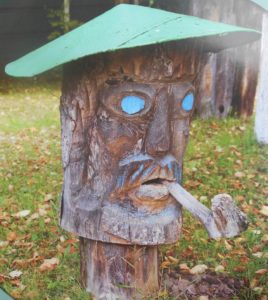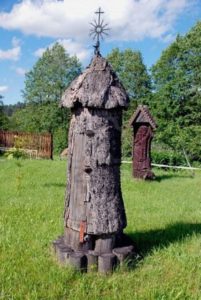Beekeepers are familiar with the saying ‘keep the bees out of the trees’? Today we say this referring to keeping bees in hive boxes in the spring, avoiding them swarming to end up in a nearby tree. Despite our best efforts, capturing swarms from trees remains part of spring bee activity. There is another meaning however when we say bees in trees. For centuries beekeepers have managed bees in trees, in the actual original tree hollows.
Some human cultures continue such traditions today. Forest beekeeping and keeping bee trees in Poland and Belarus has been nominated for listing as a UNESCO Intangible Cultural Heritage of Humanity. It already has the status of a historical and cultural value in Belarus where the ancient tradition of keeping bees in tree hollows placed high in the trees, going back to 5th-6th centuries, survives until today. There are several interesting bee Museums in Eastern Europe that show a wide variety of tree hollows to house bees.
Photo shows 2 bee trees in a Museum in Lithuania.
For centuries, bees were often “kept” where they were found and maintained in their selected cavities. When exactly humans sought to locate their bees closer to their residences in man-made hives at more convenient locations is not known. Most farmers kept other livestock and grew crops and keeping bees was only part of their husbandry/agriculture. With Reverend Langstroth’s development of the movable comb hive and comb foundation by German beekeeper Johannes Mehring, it became easier to keep honey bees at the convenience to the beekeeper.
Tree hollows selected by bees for their home are typically smaller with thicker walls than a standard beehive, and as such, better able to handle the extremes of heat and cold. Bees in tree hollows do not normally construct their parallel combs to the bottom of the cavity so a debris area exists at the base of the hollow. It remains moist and comprised of organic nutrients, decaying wood and living organisms. Within this micro-ecosystem, there are beneficial predators and microorganisms such as viruses, bacteria, fungi, wax moths, etc that may help the bees remain healthy. And since tree cavities are smaller, resulting in more frequent swarming, this natural colony reproduction helps the bees “solve” serious pest and disease issues like American foulbrood and bee mites.
The original Langstroth hive, basically a single hive body in size, had a “garbage pit” built into an incline beneath the hive. With some studies it was found that if European (Italian) bees were kept in larger boxes they would produce more honey. Along with management systems recommending a 2nd brood box for Italian bees, cell size of commercial foundations were increased to produce bigger bees.
Is it important what we keep our bees in? Beekeepers debate (and many have decided preferences) for medium depth over standard (full-depth) boxes, 8 frame boxes vs 10 frame. At turn of the century, the debate was over jumbo, 12 frame boxes vs smaller Langstroth-size boxes. You can surf the web and find hives of whatever size, shape, and construction that you can imagine. At one time the U.S. patent office had more than 100 hive patents registered.
Currently Tom Seeley, from his studies of tree bees in Cornell’s Arnot Forest, has suggested we adopt a beekeeping management approach of an Environment of Evolutionary Adaptedness (EEA – meaning we should consider adapting our livestock (our bees) to the environment to which a species has become adapted). This approach, also termed Darwinian Beekeeping, Api-centric beekeeping or “natural” beekeeping means considering some key managements to more “naturalize” our Langstroth hive beekeeping. Based on what Tom’s research has found, common to bees living in trees, some adaptions we might consider incorporating are: 1. Average is 2.5 colonies per square mile; so we should space colonies as widely as possible 2. Tree hollows are small; we should adapt by using one deep and one shallow; although we would make less honey we could have healthier colonies 3. Use rough cut lumber on inside of hive to increase propolis coating by the bees 4. Maintain 10% to 20% drone comb in our hives, as found in feral tree nests 5. Keep nest structure and especially frame position in hive intact. Do not disturb colonies in winter nor revere brood boxes in spring & limit feeding of syrup/pollen 6. Don’t use top entrances; limit bottom opening to 2 inch opening. Site colonies higher off ground.
We recommend newbees begin with what is the standard. With experience it might be interesting to see how our bees do in different hives. Top Bar for example. Or using thicker, rough-cut lumber for boxes or less intervention (but note we still need control mites to have bees survive to “play with”. And if we desire our hives look like us, design your own (as in photo below). 

